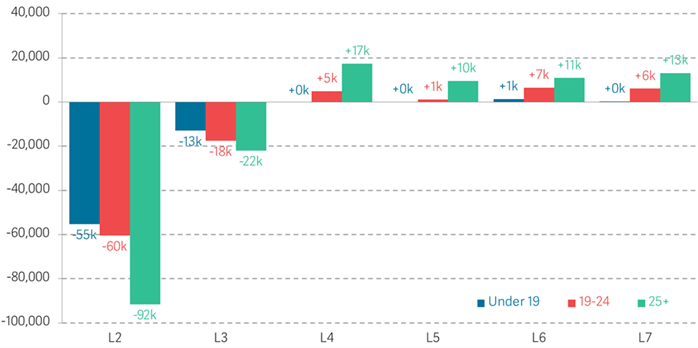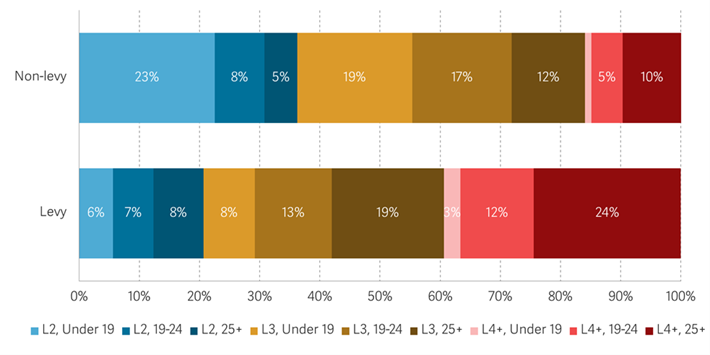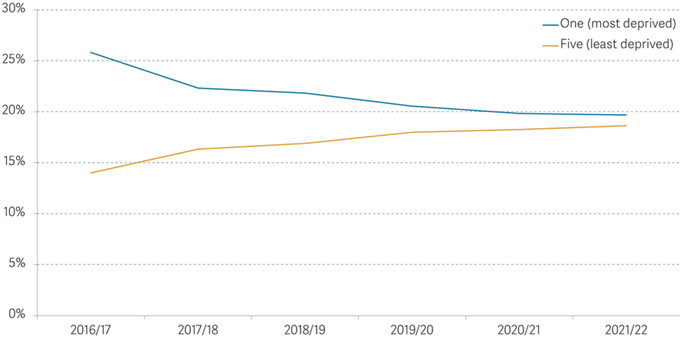Apprenticeship levy funds should be ringfenced for young people
When apprenticeships rear their head in the news, and indeed during big political and fiscal events, you often hear two assertions: first, that apprenticeships lead to great career outcomes and we should have more of them; and second, that the apprenticeship levy’s training rules are too restrictive and should be loosened to allow employers to train their staff in the most productive way possible.
There is certainly evidence to support the first point, with study after study showing that apprenticeships often improve employment and pay outcomes, especially among young people [1]. And in fairness, the second point has its merits, too: the apprenticeship model of training doesn’t fit for all firms, and in many cases, money put into the levy could have been used on training that better suits their needs.
But to understand how the two points link up, we need to take stock of what’s happened to apprenticeships since the levy came into force during 2017 – and not just changes in the overall number of apprenticeship starts, but also changes in the characteristics of apprentices that start them. It’s been well-established that the number of apprenticeship starts fell significantly in the wake of the apprenticeship levy being introduced: from 509,000 in 2015/16 to 376,000 in 2017/18 and 321,000 in 2020/21.
Figure 1 shows that between the 2015/16 and 2020/21 academic years, starts at Level 2 (GCSE-equivalent level) fell among all main age groups: by 55,000 among those under age 19, by 60,000 among 19-24-year-olds and by 92,000 among those aged 25 and older. Starts at Level 3 (A level-equivalent) fell among all main age groups too. It was only those at higher-education levels (Levels 4 and higher) that saw an increase.

Figure 1: Change in number of starts by age and level: England, 2015/16 to 2020/21. Source: DfE, Apprenticeships and Traineeships.
There are a number of reasons for this, including the fact that many of the funding rules that came in with the levy (for example, the switch to apprenticeship ‘standards,’ which included minimum requirements on apprenticeship length and training time) rendered some pre-existing programmes at Level 2 obsolete [2]. However, there is some – convincing – supposition that the types of employers who pay into the apprenticeship levy have, on average, tended to require training at higher levels of study. For example, large firms in business and professional services – who make up a large share of levy payers – tend to hire graduates in the greatest number. It’s therefore unsurprising that they’d offer apprenticeships at higher-education levels of study.
Indeed Figure 2 shows that the vast majority (over 80 per cent) of starts at non-levy-paying firms in 2021/22 were at Levels 2 and 3, including a plurality (23 per cent) taken up by under 19’s at Level 2. By contrast, four-in-ten starts at levy-paying firms were at Levels 4 and higher, including a plurality (24 per cent) of starts going to apprentices aged 25 and older at Levels 4 and higher.

Figure 2: Apprenticeship starts by age, level and levy-payer status: England, 2021/22. Source: DfE, Apprenticeships and Traineeships.
Changes in the composition of apprenticeships – at least according to age and levy – have run alongside changes in the background of an apprentice. Since 2016, the proportion of starts going to apprentices who reside in the most-deprived areas of the country has fallen: from 26 per cent in 2016/17 to 20 per cent in in 2021/22. By contrast, the share of starts among those residing in the least-deprived areas of the country has been on the rise: from 14 per cent in 2016/17 to 19 per cent in the last academic year.

Figure 3: Apprenticeship starts among those from the most and least deprived quintiles (index of multiple deprivation): England, 2016/17 – 2021/22. Source: DfE, Apprenticeships and Traineeships.
It’s clear that the introduction of the apprenticeship levy – and the lack of ringfenced funding for young apprentices – has resulted in a system that doesn’t really suit young people’s needs. With notable exceptions, the apprenticeship system in England today offers more for those already in work and who already have mid-to-higher level qualifications than it does an 18-year-old whose highest qualification is a Level 2.
Although it may improve a firm’s rates of training and development overall, adding more flex to the way employers can spend their levy money is unlikely to rebalance apprenticeships back towards the young and lower-qualified. In fact, doing so might encourage firms to focus even more resources on pre-existing staff who are already highly qualified (the types of workers least likely to be able to spare the time to meet the current system’s minimum training time requirements).
So, what does this all mean for policy? If Government are serious about improving educational pathways for the young and lower-qualified, then it’s clear that the system needs to change: either through ringfencing apprenticeship training funding for the young – or adding some further contingencies on the levy spend. The former is likely to be welcomed by educators and businesses, but the second may only add urgency to pre-existing complaints about the difficulty firms face in providing the types of training that suits their needs. Given concerns about falling rates of training in the UK [3], Government should ensure that there aren’t any impediments to firms investing in quality training that offers progression and productivity enhancements. But this shouldn’t come at the expense of young people’s training funding. Perhaps the two needs should be funded separately after all.
[1] See, for example: C Cavaglia et. al, Do apprenticeships pay? Evidence for England, Centre for Vocational Educational Research, London School of Economics & Political Science, September 2018.
[2] K Henehan, Trading up or trading off? Understanding recent changes to England’s apprenticeships system, Resolution Foundation, August 2019.
[3] K Henehan, Pick up the pace: the slowdown in educational attainment growth and its widespread effects, Resolution Foundation, March 2019.
It’s clear that the introduction of the apprenticeship levy – and the lack of ringfenced funding for young apprentices – has resulted in a system that doesn’t really suit young people’s needs.


